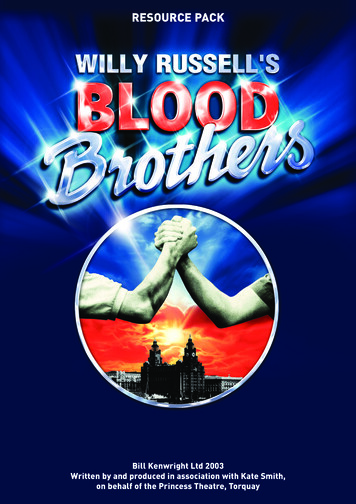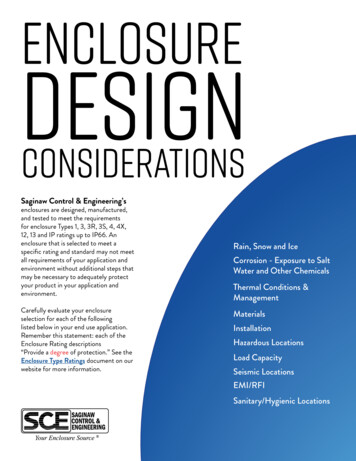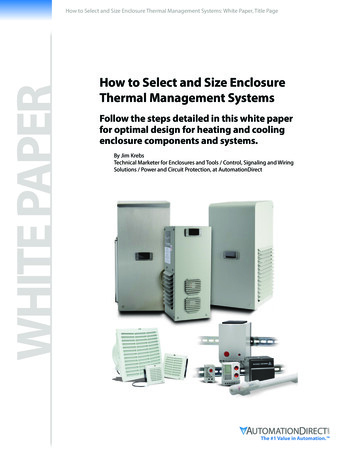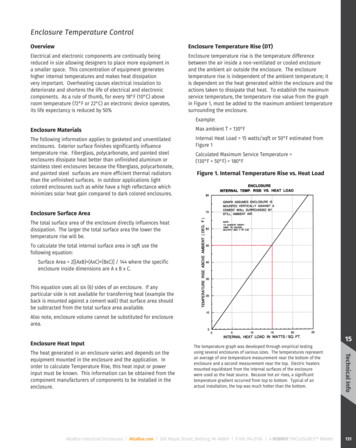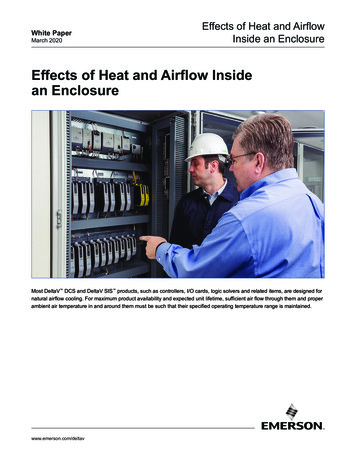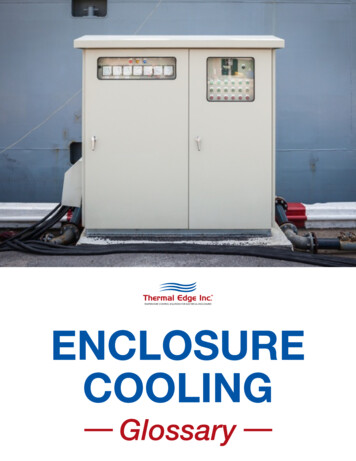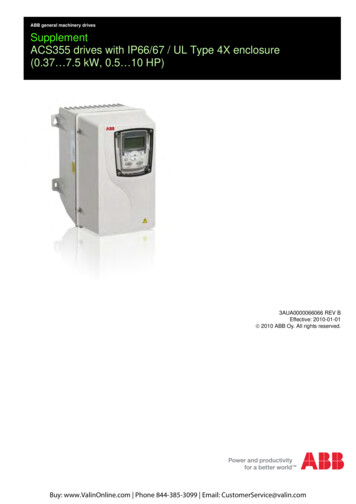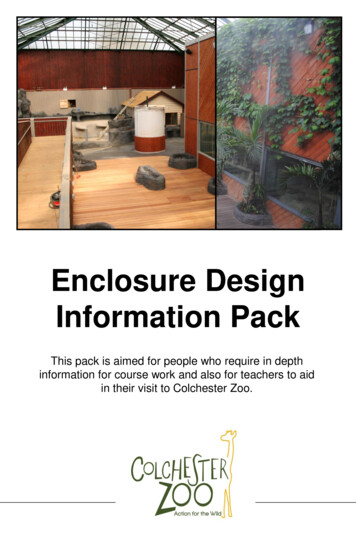
Transcription
Enclosure DesignInformation PackThis pack is aimed for people who require in depthinformation for course work and also for teachers to aidin their visit to Colchester Zoo.
ContentsContentsPageHistory of Keeping Animals1History of Enclosure Design2Zoos in the 21st Century4Laws and Considerations5The Animals’ Natural History6The Animals’ Needs7Staff Needs9Visitor Needs10Types of Barriers11Enclosure Size14Mixed Species Enclosures15Filter Systems16Points to Remember17Enclosure Design: Patagonian Sealion18Enclosure Design: African Elephant19Enclosure Design: Amur Tiger20Enclosure Design: Orangutan21Enclosure Design: Komodo Dragons22Enclosure Design: Lorikeets23Enclosure Design: Humboldt Penguins24
History of Keeping AnimalsAs understanding of animals increases and technology advances, the way animals are housedin zoos has changed and will continue to change.Public attitudes can also affect how animals are housed. What was considered acceptable 20years ago, may not be accepted now. New laws and regulations further impact on how theanimals are housed and managed.Animals have been kept in captivity for thousands of years for a number of reasons.In ancient Egypt, animals were asign of power and wealth, as seenin these paintings.In ancient Rome, animals wereused to fight each other orgladiators for entertainmentFrom the 13th century, the royalcollection was kept at the Tower ofLondon where people could pay tosee the animals.In the 1800’s, zoos were places ofscientific interest and were morelike living museums.1
History of Enclosure DesignPeople’s attitudes towards animals and nature has changed since the early days of zoos.Before, the welfare of the animal wasn't a factor in the design of the enclosure and what wasconsidered the acceptable way to keep animals is very different to what is deemed acceptabletoday.The three pictures below show some examples of how enclosure design has changed. With abetter understanding of animal welfare and the natural world, combined with improvements intechnology, enclosures now are very different to how they were and now emphasis is on morenatural looking, realistic designs rather than a stylised look.Animals were kept in a manner that displayedthem on show at all times and kept in singlespecies’ enclosures. Seen more as curiositiesrather than living things.In 1907, the use of moats and hidden barrierswere used at Hamburg Zoo in Germany. Thisshowed animals in a more natural lookingenvironment and showed multiple species in thesame area. The first enclosure to do this canbeen seen in the picture and was so successful,it is still used today.Enclosures are now becoming more about thewhole habitat rather than just about the animal.Some zoos are creating ecosystems with realplants and multiple species of animals. Thevisitors are often able to use walkways to be inthe enclosure. This is called immersion design2
Then and NowThe following pictures show examples of how enclosure design has changed. The pictures on the leftshow how some of the enclosures looked at Colchester Zoo and the pictures on the right show theenclosures now.The white rhino enclosure late 1980’sThe white rhino enclosure late 2000’s Richard MartinThe lion enclosure early 1960’sThe lion enclosure mid 2010’s Sheelagh Marron-BorisThe penguin enclosure late 1970’sThe penguin enclosure late 2015 Peter Jennings3
Zoos in the 21st CenturyIn the 21st century, zoos fulfil four main roles: ResearchConservationEducationRecreationBetter understanding of animal behaviour and welfare, combined with zoos focusing oninternational breeding programmes and education, have all impacted on how zoos designenclosures.Many zoos are members of national, regional and international zoo associations, all of whomhave their own criteria for how animals should be housed and looked after. Colchester Zoo is partof three associations:BIAZATheand Irish Association of Zoos andAquariaa conservation, education andscientific wildlife charity, ensuring theprinciples and practices of animalmanagement.EAZAThe European Association of Zoos andAquaria is a conservation, education andscientific wildlife association whocoordinate breeding programmes withinEuropean zoos.Every continent have their own equivalentof EAZA.WAZAThe World Association of Zoos and Aquariaprovide leadership and support for zoos,aquariums, and associations of the world inanimal care and welfare, conservation ofbiodiversity, environmental education andglobal sustainability.4
Laws and ConsiderationsZoos in the U.K. are also subject to U.K. and European Laws.The EU Zoo Directive and Zoo Licensing Act 1981 state that zoos must:“Accommodate their animals under conditions which aim to satisfy the biological andconservation requirements of the speciesto which they belong”The U.K. Animal Welfare Act 2006:The Welfare Act 2006owners and keepers responsible for ensuring that the welfare needs oftheir animals are met. These include the need: for a suitable environment (place to live) for a suitable diet to exhibit normal behaviour patterns to be housed with, or apart from, other animals (if applicable) to be protected from pain, injury, suffering and diseaseWhen designing a new enclosure there are several factors that needs to be part of the process,along with the aforementioned laws and regulations.One key part to remember is there are three groups to consider when it comes to designingenclosures. The animalThe staffThe visitorZoos have to find a balance between all three to ensure the animal has good welfare, thekeeper can work safely and that visitors can see the animal, which they have paid to see.When designing an enclosure, there are several factors that need to be considered. What type of animal is it?How many animals the enclosure is going to house?Physical healthMental healthGeneral maintenanceEducationSafetyVeterinary CareOn a basic level an enclosure should allow the animal to express as many natural behavioursas possible, allow the animal to feel safe and provide education to the visitors.5
The Animals’ Natural HistoryThe term natural history refers to the behaviour of the animal, the animal’s natural habitat andthe adaptations they have.For example, a Patagonian sealion comes from the cold seas off the coast of South America.The seas are cold due to the Humboldt current that comes directly from the seas aroundAntarctica. They live in groups and spend most of their time in the water. They have thickwaterproof fur and a layer of blubber under the skin to help them keep warm.When designing an enclosure for these sealions, the enclosure must allow them to swim as theyspend most of their time in the water and allow more than one individual to live in the enclosureas they live in groups. The water should not be heated as they are adapted to the cold sea, andif the water was warm they would overheat. They will also spend time on land to rest so thereshould also be a beach area.For animals that are arboreal (tree dwelling) it is important that they are given the opportunity toclimb. This can be done by having actual trees and plants in the enclosure and/or climbingframes and ropes. Climbing frames are useful and allow for complex designs, however, theyare solid structures and this can make the climbing too easy for the arboreal animal. The use ofropes will make a climbing frame much more interesting and make climbing a bit harder andthus better for exercise.Mangabey enclosureSquirrel monkey outside enclosure6
The Animals’ NeedsThe physical and mental health of the animal must be maintained. This can be done in a varietyof ways.One way is making sure the enclosure is suited to the animals by looking at the animals’ naturalhistory as mentioned on the previous page. Animals that burrow and dig should be able to doso, for example. The correct temperature should also be maintained especially for reptiles andspecies that come from tropical regions. It should also be remembered that animals that comefrom cold regions are given methods to stay cool and not overheat; this can be done by nothaving any heating in the enclosure, for example the Amur tiger copes with temperatures of –40degrees C in the wild so they will often spend most of the day outside during winter and preferto sleep in the snow. In addition, providing pools to cool off or having a sprinkler system canhelp animals get more comfortable in very hot weather. Heated rocks and heat lamps can beused for animals that prefer some warm rather than a constant warm temperature.The correct social grouping is important. Having a solitary animal in a large group will have anegative impact on the animal and having a social animal on their own will do the same.Regardless of how sociable an animal is, it is important that retreats are available to allowprivacy from certain members of the group, but also from visitors. These can be a purpose-builtstructure or strategic plants to provide cover and visual barriers.Ensuring the animals have several shelters to get shade or get out of the rain are important.Also it is important for social animals with a hierarchy, which will prevent any low rankingmembers being left outside.If the animals are in a breeding situation, having somewhere the mothers can feel safe and reartheir young is vital. If the animal makes nests there should be provision of nesting materials, aswell as locations to build the nest.7
The Animals’ NeedsEnsuring the mental health of the animals is met through enclosure design can be achieved byproviding opportunities to express as many natural behaviours as possible.If the animal swims, providing a pool which is large enough and deep enough for them toexpress this behaviour is important, for example.Allowing the instalment of enrichment is vital as well. Enrichment is providing the animalsmental stimulation and keeping them active and interested. This can be in the form of puzzlesthe animals have to work out in order to get food, or novel objects that they can interact with,such as toys. It can also be smells and sounds as well. The pictures below show someexamples of enrichment that is done at Colchester Zoo.8
Staff NeedsTo ensure the health of the animal and that the enclosure is maintained, there are manyconsiderations needed to ensure staff can work in and around the enclosure. These include: Safety—Canthe staff work in the enclosure with minimal risk of injury? Are the animalssecure to prevent contact that could result in injury? Security—Is the animal secure to prevent escapes and non-staff members entering theenclosure? Ease of access—Can the staff get to all areas of the enclosure? Can they clean andmaintain the enclosure easily? Clear view of the animal—Can the staff see the animal clearly in order to do visual healthchecks and to count the animals? Ability to separate individuals—Can the staff do this quickly and safely? Storage—Can tools be kept safely out of the way? Is there enough room for the staff to moveand store food and enrichment items? Can bedding and other such materials be kept in easyreach? Prep areas—Is there a place to prepare food and enrichment? Training areas—Is there a place to safely train animals for health checks? Ease of access—Can all the areas of the enclosure be reached to clean? Can stores bestocked up easily?9
Visitor NeedsThe visitors are an important group to consider when designing an enclosure. They have paid tosee animals, this means a balance between the visitors’ desire to see the animal and theanimals’ need for privacy is important.This can be achieved by: The type of barrier usedThe distance between the animal and the visitorHave feed/talk times. This allows visitors to come at a specific time to see the animal.There is also an opportunity to educate the visitors by making the enclosure look like theanimals’ natural habitat and signage to tell the visitor about the animal, as well as anyconservation work being done.The visitor needs to be safe to avoid risk of being injured and to ensure the visitor cannot getinto the enclosure.The enclosure should also be accessible to all visitors of any age and ability.A way to try and encompass all these aspects is through ‘enclosure immersion’. This is whenthe line between the enclosure and the public viewing is blurred. This can be done by makingthe visitor area look the same, through planting and theming the areas in the same way as theanimals’ enclosure, and in some cases, using sounds and smells to make a multi-sensoryexperience for the visitor.Zoos are in a unique position to raise awareness of the problems animals face in the wild, aswell as helping to build a better understanding and respect towards nature.One way to do this is through the enclosure interpretation. Signs, artwork and interactive signsare used to inform the visitor about the animal, but also of the habitat and conservation issuesthe species may face. Information on the local people and culture can also be used, helping withincreasing the awareness of the world.10
Types of BarriersThere are a number of different types of barriers that can be used depending on the species,budget and space available. It is worth noting the type of barrier used, due to the need to keepthe visitor out as well as the animal in.Below are some examples of different barriers with pros and cons.Uneven Ground:Pros Doesn’t obstruct the view of the animals Looks natural and blends inCons Takes up space Risk of foot/leg injuries towards the animalsFine MeshPros Unobstructed view Doesn't take up much spaceCons Can be expensive Usually needs another barrier as won’t stopvisitors putting fingers throughPlantsPros Unobstructed view Good for immersionCons Usually needs another barrier as won’t stopvisitors putting fingers and arms through Takes time to establishMetal gridsPros Unobstructed view Works in all weathersCons Usually needs another barrier as won’t stopvisitors gaining access to the enclosure Can look harsh11
Types of BarriersThere are a number of different types of barriers that can be used depending on the species,budget and space available. It is worth noting the type of barrier used, due to the need to keepthe visitor out as well as the animal in.Below are some examples of different barriers with pros and cons.Mesh/bar fencing:Pros Don’t take up a lot of space Can allow animals to use as climbing (dependingon if a roof is included)Cons Can obstruct the view Visitors can show negative feeling towards it, asit looks “cage like”.Dry Moat (Ha-ha)Pros Unobstructed view Works in all weatherCons Need a lot of space Usually needs another barrier as won’t stopvisitors gaining access to the enclosure.Water MoatPros Unobstructed view Good for immersionCons In winter can freeze, allowing animal/visitor tocross. Need a lot of spaceStand-off BarrierWith any fence type a stand-off barrier should beused to prevent visitors getting too close to mainbarrier. This helps in preventing injury to the visitoreither from the animal or from falling into a moat.It can also help in increasing the distance the visitoris from the animal.12
Types of BarriersBarriers can also allow different opportunities to view the animal. The pictures below show otherbarriers that can be used to allow for the visitor to view the animal in a different way.FencesUsed to offer unobstructed views and allows thevisitors to hear and smell the animals as well.Under water tunnels:Ideal to see animals that spend a large amount oftime in water.Having a tunnel is more immersive than a window.Platforms:Offers a vantage point for large enclosures and inenclosures that house animals that can climb, itbrings the visitor to the animals’ level.Windows:Can be used instead of mesh or bars to offer a softlook to the enclosure. Needs minimal space anddoesn't need a stand off barrier.Allows visitors of all ages and abilities to see theanimal.13
Enclosure SizeIt is worth remembering one saying when it comes to enclosure design:Quality not quantityAn enclosure that looks good should also cover the same needs as any enclosure and nomatter how much space an animal has, if it cannot use it, it is worthless space.For example, if there is a group of arboreal (tree-dwelling) primates and they have a large grassenclosure with a climbing frame in the middle, the chances are they will spend their time on theclimbing frame and not use the open grass area.Whereas a group arboreal primates in an enclosure with climbable walls and roof, as well as aclimbing frame, would use nearly every part of the enclosure. This is because arboreal primatesare 3D animals, this means they will use all parts of their environment compared to a 2D animalsuch as a white rhino that can only use the floor area.Visitors will also judge how an animal is kept by how the enclosure looks. This has been asubject for many scientific papers. It does not matter how well the enclosure works for theanimal and staff, if the enclosure doesn't look nice the visitor will think the animal is not beinglooked after properly.One concern that visitors have is that the animal doesn't have enough space compared to thespace they may have in the wild. The size of a territory or areas used by the animal is due to theavailability of resources.In the wild if a water source, a food source and, if needed, shelter are close by, the used areawill be small. If the resources are far apart the area will be larger.The key point to remember is in captivity enough space should be provided that allows animalsto have privacy, allows animals to move themselves away from other individuals and to allow theexpression of as many natural behaviours as possible.14
Mixed Species EnclosuresA way that animals can be housed is in a mixed species set up. This is where more than onespecies are kept together. The species that are mixed are from the same habitat and are foundliving in close proximity to one another in the wild.There are several factors that need to be considered when housing multiple species in the samespace. Large enough space to allow the species to move away from each otherMultiple feeding areasMultiple drinking areasAreas to introduce new arrivals safely to the other speciesBarriers that are suitable for all the speciesThe different species should have their own house or area within a larger housePredators and prey should not be mixedWhen setting up a mixed species enclosure, it is worth remembering that individuals may notsuit this environment and that mixing the different species will take time.During breeding seasons, some species may need to be removed if males are sparing. Thisavoids other species getting caught in the crossfire.Mothers with young may need to be kept away from otherspecies to avoid injury to the young and mothers will bemore protective of their young and thus show higher levelsof aggression towards other species.At Colchester Zoo, the largest mixed species enclosureis The Spirit of Africa, which houses a herd of giraffe, abreeding group of white rhinos, a flock of ostrich, agroup of kudu antelope and zebra and a flock of crowned cranes.Other mixed species enclosures at Colchester Zoo include: The Rainforest Walkthrough with golden headed lion tamarins, Geoffroy's marmosets, twotoed sloths and, on warm days, green iguanas and tortoises.The Worlds Apart Walkthrough with two-toed sloth, golden lion tamarins and titi monkeysColenso Village with pygmy goats and Cameroon sheepLost Madagascar with red bellied lemurs, red ruffed lemurs and ring tailed lemursA variety of fish are also mixed together in fresh water tanks or marine tanks around the zooBinturongs and short clawed ottersWeavers birds and tortoises15
Filter SystemsAnimals that spend a large amount of time in water need to have the water filtered to ensure thewater is clean and safe for the animals. Below is a walkthrough of the filter system used at thesealion enclosure at Colchester Zoo.
having any heating in the enclosure, for example the Amur tiger copes with temperatures of –40 degrees C in the wild so they will often spend most of the day outside during winter and prefer to sleep in the snow. In addition, providing pools to cool off or having a sprinkler system can . Security—Is the animal secure to prevent escapes .
